

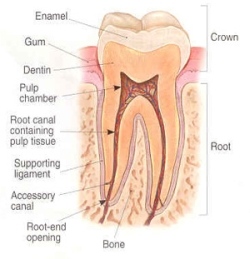
To understand Endodontic treatment, it helps to know something about the anatomy of the tooth. Inside the tooth, under the white enamel and a hard layer called the dentin, is a soft tissue called the pulp. The pulp contains blood vessels, nerves and connective tissue, and creates the surrounding hard tissues of the tooth during development.
The pulp extends from the crown of he tooth to the tip of the roots where it connects to the tissues surrounding the root. The pulp is important during a tooth’s growth and development. However, once a tooth is fully mature it can survive without the pulp, because the tooth continues to be nourished by the tissues surrounding it.
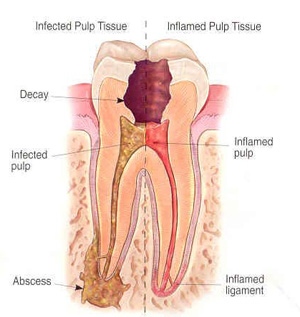
The inflammation or infection can have a variety of causes: deep decay, repeated dental procedures on the tooth or a crack or chip in the tooth. In addition, a blow to a tooth may cause pulp damage even if the tooth has no visible chips or cracks. If pulp inflammation or infection is left untreated, it can cause pain or lead to an abscess.
Signs of pulp damage include pain, prolonged sensitivity to heat or cold, discoloration of the tooth and swelling and tenderness in the nearby gums. Sometimes, there are no symptoms.
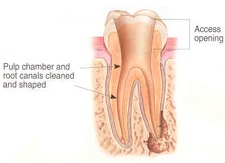
The Endodontist examines and x-rays the tooth, then administers a local anesthetic. After the tooth is numb, the Endodontist places a small protective sheet called a “dental dam” over the area to isolate the tooth and keep it clean and free of saliva during the procedure.

The Endodontist makes an opening in the crown of the tooth. Very small instruments are used to clean the pulp from the pulp chamber and root canals, and to shape the space for filling. A more advanced method uses water laser technology to clean and sterilize the entire area.
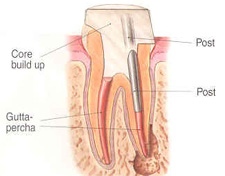
After the space is cleaned and shaped, the Endodontist fills the root canals with a biocompatible material, usually a rubber-like material called “gutta-percha”. The gutta-percha is placed with an adhesive cement to ensure complete sealing of the root canals.
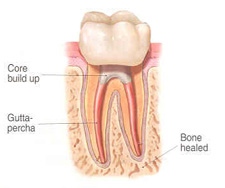
If the tooth lacks sufficient structure to hold the restoration in place, your dentist or Endodontist may place a post inside the tooth.
Your dentist may then permanently restore the tooth by placing a filling in the opening or a crown over the tooth for aesthetics and to protect the tooth from chewing pressures. This extra step is highly recommended for all Endodontically treated teeth.
The material used to fill your root canal will probably last you a lifetime, but the filling or crown may eventually need to be replaced.